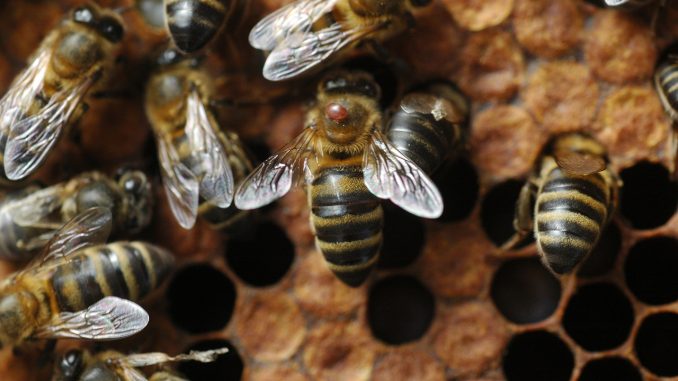
Previously I used Hiveclean as Varroa treatment, both before supers went on in spring and again at the end of summer when honey was taken off. However, Hiveclean has been withdrawn and is no longer available.
So I decided to treat for Varroa this summer using MAQS (Mite Away Quick Strips) which contain formic acid. At the recent Bee Disease Day, Keith Morgan our Regional Bee Inspector, described the best way to apply this treatment: He recommended that mesh floors are closed by inserting the monitoring tray, in order to keep in sufficient fumes, but allow a wide entrance so the bees are not exposed to excessive fumes. Keith also recommended that a couple of supers be placed above the brood box with no queen excluder; allowing the queen to move away from the fumes if she needed to.
In the event I decided to use just one MAQS pad per colony (rather than the recommended dose of two pads per colony) to err on the cautious side, as I have heard reports of queens dying as a result of this treatment. Using a low dose of MAQS will not cause Varroa mites to become resistant to the treatment, as happened with the pyrethroid insecticides in Apistan and Bayvarol. My mesh floors are homemade and not designed to take a monitoring tray. Luckily I kept my solid floors from years ago and brought them back into use. I moved the whole colony to one side, placed the solid floor on the stand and replaced the hive, including the mesh floor, on top of the solid floor. This allowed the mites to fall through the mesh onto the solid floor for a visual check at the end of treatment. The bees did not have access to the solid floor so they would not remove any debris or mites.
It is not realistic for me to monitor the mite drop in my hives due to the number of colonies I run. So the only way I can assess varroa levels is by forking out drones around June time. But looking at the mite drop after a seven day treatment shows me the level of infestation in each colony.
MAQS is a seven-day treatment. I did not have enough floors to treat all hives at the same time. I was also cautious and wanted to see how colonies fared after treatment. So I treated a few at a time.
When I started removing the solid floors and checking the mite drop, initially I was concerned that the treatment may not have worked well as there were only tens of mites. I was not sure if I was under dosing or whether the volume of the hive was too great.
Then I came to remove the floors from five colonies that have Danish Buckfast queens which I bought last year. These queens are prolific with large brood nests and high populations of bees since early spring. They were very productive in honey gathering and most did not swarm in their first season. The mite drop from these colonies was in the hundreds. So I contacted Keith Morgan to ask why the mite count was so high. In his opinion strong colonies such as these are Varroa factories. Because so much brood is produced – and Varroa mites reproduce in the brood – there are greater numbers of mites. Also these large colonies produce more drones – Varroa reproduces faster in drone brood than worker brood – increasing mite numbers further. Finally, with no swarming – and therefore no break in brood production – there is no break in mites multiplying. Incidentally, low swarming impulse is another benefit of these queens.
According to the instructions, MAQS can be used with honey on the hive. However, my policy is to remove honey before treating, so there is no possibility of contamination.
We cannot rely on a single treatment per year as mite numbers can build up to dangerous levels.
My next treatment will be trickling oxalic acid in December. This treatment is effective and I have used it for several years. I may give a MAQS pad to my Danish queens next April just to try and keep mite levels low before the colonies build up.
If you haven’t treated for Varroa yet, please do use something soon. Strong colonies which did not swarm this year can be more prone to Varroa damage. It is important to produce healthy winter bees now to keep the colony going till next spring.
Wally Thrale
P.S. The National Bee Unit website BeeBase has an advisory booklet “Managing Varroa” which you can download free. This explains how to monitor Varroa levels in colonies and lists all the available techniques and treatments for reducing Varroa numbers in our colonies and keeping them healthy.

Thanks for the article Wally, very interesting. I have used a mix of MAQS and ApiGuard this year depending upon colony size and strength. I’ve had mixed results with MAQS in past years with some queen loss but overall it’s a much easier treatment to administer.